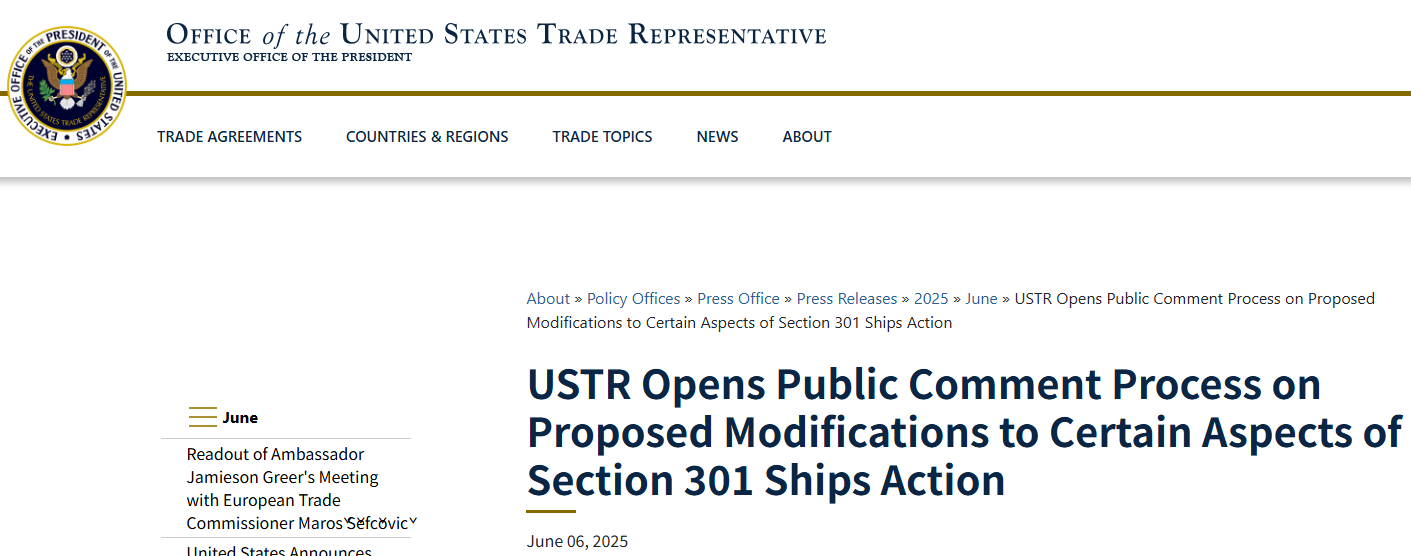The Office of the United States Trade Representative (USTR) has decided to further adjust its proposed port fee structure for Chinese-built ships, focusing on some provisions related to PCTCs and U.S. liquefied natural gas (LNG) exports.

On June 6, the USTR announced announced a public comment process to consider proposed modifications to certain aspects of Annexes III and IV in the action (90 Fed. Reg. 17114, April 23, 2025) in the Section 301 Investigation of China’s Targeting of the Maritime, Logistics, and Shipbuilding Sectors for Dominance with a focus on modifications to the fee structure for PCTCs and changes to the licensing requirements for LNG exports. The deadline for submission of comments is July 7, 2025.
USTR proposed changing the PCTC charging standard from car equivalent unit (CEU), saying the move would better align with commercial enforcement and tax norms, thereby reducing fees for larger vessels with smaller cargo spaces.
Prior to the modification, the USTR required a fee of $150 CEU effective October 14, 2025, with a three-year fee waiver for specific vessels if the owner orders and takes delivery of PCTCs of equal size or higher CEUs in the U.S. After the modification, the fee structure for each PCTC was adjusted to be based on net tonnage.
The USTR explains that the change makes it easier to administer fees and helps avoid potential avenues for tax evasion. Similar to lane meters, net tonnage is a measure of the vessel rather than the cargo, so even empty PCTCs arriving at a port in ballast are still subject to fees – and this has previously been strongly criticized by non-US people.
At the same time, USTR is proposing a “targeted coverage” fee for foreign-built PCTCs participating in the U.S. Maritime Security Program (MSP). The agency noted that the MSP is designed to “reduce dependence on China,” which is the central goal of the new port fees.
In terms of LNG exports:
The USTR proposes to delay implementation of the “U.S.-Built LNG Carrier Requirement” for U.S. LNG exports and to remove the license suspension provision.
Before the modification, USTR required that the proportion of US vessels used in US LNG exports should be gradually increased from 1% to 15% from 2028 to 2047. If LNG exporters fail to reach the appropriate percentage of vessels within the specified time, their LNG export licenses will be suspended. After the amendment, USTR proposed to delete the license suspension clause to “alleviate concerns about the impact of the clause on the US LNG industry.”
The reason for the adjustment to the LNG industry requirements is that the U.S. does not currently have LNG carriers built by its own shipyards: the last LNG carriers built by U.S. shipyards were commissioned in 1980 and scrapped in 2021, and the shipyards that built the LNG carriers were shut down in 1986.
USTR said that given the challenges of expanding the U.S. LNG carrier construction program within four years – a prospect that is uncertain and accompanied by real technical risks – LNG exporters have informed USTR that they hope to cancel the suspension of licenses if the vessels cannot be built and delivered before 2028. At present, USTR has agreed to the modification request of U.S. LNG exporters.
In addition, the USTR is seeking comment on expanding the scope of the restrictions in Annex IV of the Port Dues Rule (for certain maritime transportation services), which is proposed to extend the restrictions from charterers and service providers only to shipowners and operators, and may significantly expand the scope of enforcement affecting domestic and foreign entities associated with China.
The USTR asserted that the decision to amend port fee rules was intended to reduce regulatory uncertainty regarding energy exports and said that it “helps address the disadvantages faced by U.S. companies and workers as a result of China’s policies.”
In February 2025, USTR officially announced the results of the Section 301 investigation into “China’s dominant position in the maritime, logistics and shipbuilding industries”, and determined that “China’s dominant position in the maritime, logistics and shipbuilding industries is actionable, and China’s actions against its dominant position are unreasonable and impose burdens or restrictions on U.S. commerce.”
Two months later (April 17), USTR announced the specific restrictive measures after the above-mentioned 301 investigation, claiming that it would address “China’s unreasonable behavior, policies and practices in dominating the maritime, logistics and shipbuilding industries.” Specifically, it will impose a 25% tariff on maritime and shipbuilding-related goods, impose port fees on Chinese-built vessels, and impose export license restrictions if China is found to have taken retaliatory measures or failed to comply with regulations.
The port fee policy is planned to be implemented in two phases, with the applicable fee set at $0 for the first 180 days: phase 1, which will take effect after 180 days (October 14, 2025); and phase 2, which will officially take effect after three years.


